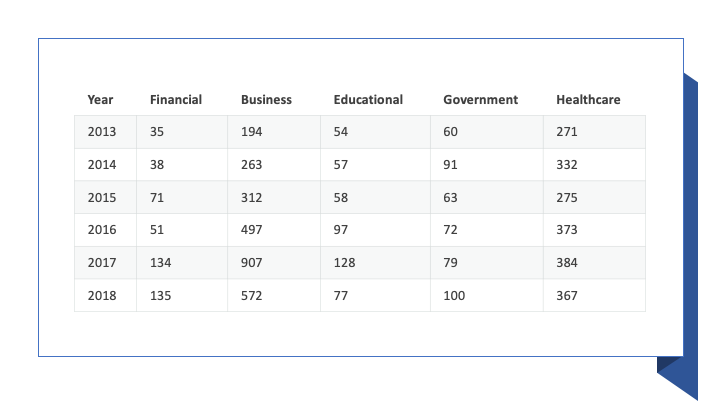Across the board, the number of data breaches and security incidents continue to rise every year, but some industries are feeling the pressure more than others. While there are different types of breach, the US Department of Health and Human Services defines a data breach as “a security incident in which sensitive, protected or confidential data is copied, transmitted, viewed, stolen or used by an individual unauthorized to do so.”
With these numbers increasing, and many jurisdictions having passed their own laws around data breach notifications due to the wide-ranging impact on individuals and organizations, it has never been more important to take steps to secure organizational data and facilities.
What kind of information is at risk?
- Personally identifiable information, including social insurance/security numbers
- Trade secrets
- Intellectual property
- Bank details
- Credit card information
US Data Breaches by the Numbers

© Statista 2020. All further information on this statistic can be found at Statista
Based on this data, three industries at great risk of data breaches are:
-
- Businesses and Corporations
According to Verizon, in 2019, C-level executives were 12 times more likely to be the target of social incidents and nine times more likely to be the target of social breaches than in previous years. Beyond trade secrets and organizational information, many companies’ corporate campuses are targeted for the customer information that is available in call centers and data hubs, including credit card details and email addresses. - Medical and Healthcare Services
In the healthcare space, the number of patients affected by data breaches more than doubled from 2018 to 2019 in the United States, with one report stating that more than 27 million people have been affected. - Banking and Financial Institutions
The kind of information at risk in banks and financial institutions demands the utmost in security. With personally identifiable information, banking details and social security information on the line, breaches in this industry have the potential to be devastating to individuals, and severely damaging to the organizations that fail to protect this sensitive information.
- Businesses and Corporations
According to IBM’s Cost of a Data Breach Report, while the global average cost of a data breach is an astounding $3.9 million, that number pales in comparison to the average total cost of a data breach in the United States, which clocked in at a whopping $8.19 million in 2019. It’s a risk that companies would be wise to mitigate to the best of their abilities, as that cost is not immediately identifiable. According to the same report, in 2019 the average time to identify a breach was 206 days, and it typically took a further 73 to days to contain it, and the reverberations will be felt for years to come.
With the stakes so high, it begs the question, how can organizations in these high risk industries afford not to take steps to secure their buildings and systems? While many data breaches occur offsite through remote hacking, there are many that take place because of data exfiltration via wireless rogue eavesdropping devices or rogue wireless access points within the facility. Implementing a wireless device detection system is a great initial step for organizations to protect their data.
We are here to help you create a smart and secure workspace. To learn more about how you can leverage Inpixon’s Indoor Intelligence solutions, contact our team to schedule a consultation today.

